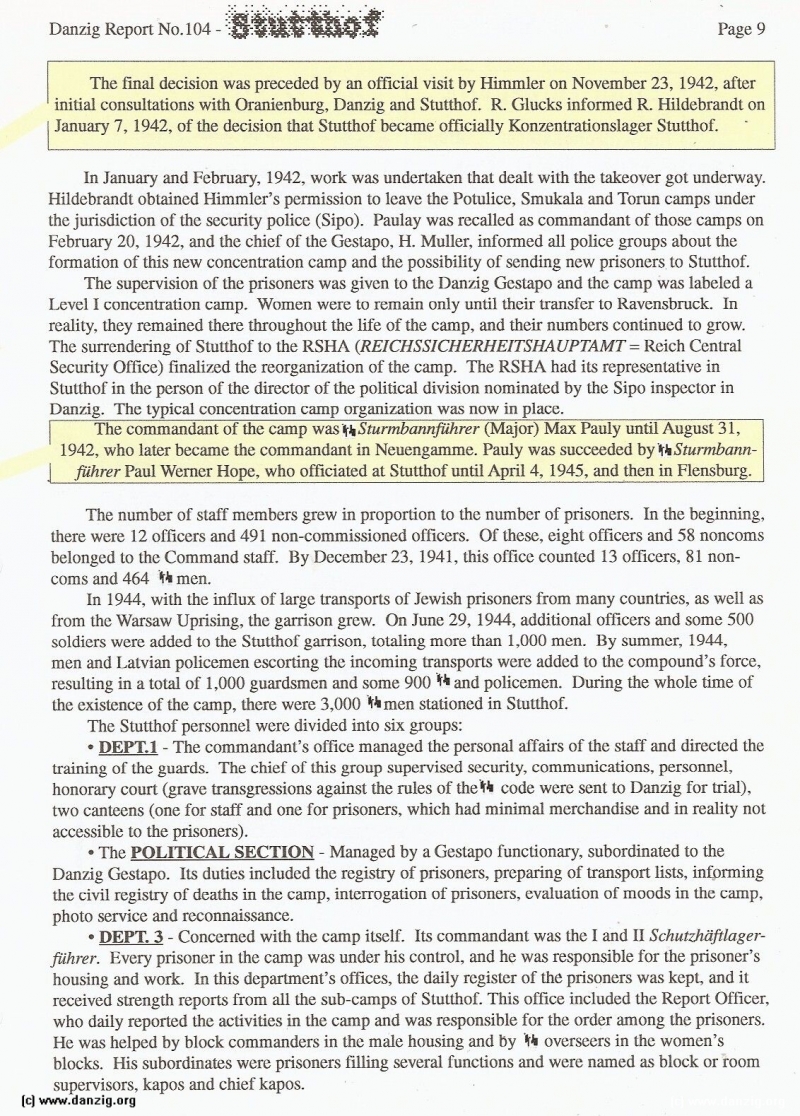
The final decision was preceded by an official visit by Himmler on November 23, 1942, after initial consultations with Oranienburg, Danzig and Stutthof. R. Glucks informed R. Hildebrandt on January 7, 1942, of the decision that Stutthof became officially Konzentrationslager Stutthof.
In January and February, 1942, work was undertaken that dealt with the takeover got underway. Hildcbrandt obtained Himmier’s permission to leave the Potulice, Smukala and Tonin camps under the jurisdiction of the security police (Sipo). Paulay was recalled as commandant of those camps on February 20, 1942, and the chief of the Gestapo, H. Muller, informed all police groups about the formation of this new concentration camp and the possibility of sending new prisoners to Stutthof.
The supervision of the prisoners was given to the Danzig Gestapo and the camp was labeled a Level I concentration camp. Women were to remain only until their transfer to Ravcnsbruck. In reality, they remained there throughout the life of the camp, and their numbers continued to grow. The surrendering of Stutthof to the RSHA (REICHSSICHERHEITSHAUPTAMT = Reich Central Security Office) finalized the reorganization of the camp. The RSHA had its representative in Stutthof in the person of the director of the political division nominated by the Sipo inspector in Danzig. The typical concentration camp organization was now in place.
The commandant of the camp was Sturmbannfuhrer (Major) Max Pauly until August 31, 1942, who later became the commandant in Neuengamme. Pauly was succeeded by 41. SturmbannJ führer Paul Werner Hope, who officiated at Stutthof until April 4, 1945, and then in Flensburg.
The number of staff members grew in proportion to the number of prisoners. In the beginning, there were 12 officers and 491 non-commissioned officers. Of these, eight officers and 58 noncoms belonged to the Command staff. By December 23, 1941, this office counted 13 officers, 81 non- corns and 464 1. men.
In 1944, with the influx of large transports of Jewish prisoners from many countries, as well as from the Warsaw Uprising, the garrison grew. On June 29, 1944, additional officers and some 500 soldiers were added to the Stutthof garrison, totaling more than 1,000 men. By summer, 1944, men and Latvian policemen escorting the incoming transports were added to the compound’s force, resulting in a total of 1,000 guardsmen and some 900 and policemen. During the whole time of the existence of the camp, there were 3,000 ‘ men stationed in Stutthof.
The Stutthof personnel were divided into six groups:
DEPT.1 - The commandant’s office managed the personal affairs of the staff and directed the training of the guards. The chief of this group supervised security, communications, personnel, honorary court (grave transgressions against the rules of the13. code were sent to Danzig for trial), two canteens (one for staff and one for prisoners, which had minimal merchandise and in reality not accessible to the prisoners).
The POLITICAL SECTION - Managed by a Gestapo functionary, subordinated to the Danzig Gestapo. Its duties included the registry of prisoners, preparing of transport lists, informing the civil registry of deaths in the camp, interrogation of prisoners, evaluation of moods in the camp, photo service and reconnaissance.
DEPT. 3 - Concerned with the camp itself. Its commandant was the I and II Schutzhaftlagerf ührer. Every prisoner in the camp was under his control, and he was responsible for the prisoner’s housing and work. In this department’s offices, the daily register of the prisoners was kept, and it received strength reports from all the sub-camps of Stutthof. This office included the Report Officer, who daily reported the activities in the camp and was responsible for the order among the prisoners. He was helped by block commanders in the male housing and by 11. overseers in the women’s blocks. His subordinates were prisoners filling several functions and were named as block or room supervisors, kapos and chief kapos.
Danzig Report Vol. 1 - Nr. 104 - July - August - September - 1999, Page 9.
Hits: 3490
Added: 25/07/2015
Copyright: 2024 Danzig.org

